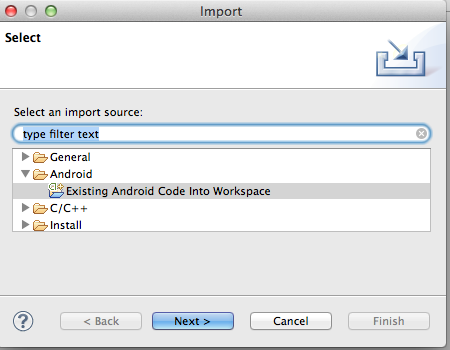
Even though the HelloWorld program is trivial it introduces a wealth of new ideas -- the framework, activities, manifest, intents, UI, resources such as layouts, strings, etc. I know all just to print Hello World! There is a lot to take in regarding the Android program plumbing but an important separation principal presented in the single HelloWord is the separation between UI design in XML and the program.
Next, we consider a more complex program with multiple UIs, activities and intents -- it's called MyFirstApp and the code is linked in so you can download and run it.
What this lecture covers:
Download the demo the myfirstapp.zip app to go with these notes.
I recommend that you code this project up from the notes rather than just import the project to Eclipse/ADT and run it -- but feel free to do that if you really want. As a rule I will include all source code examples and projects used in course when I can.
For each of the demo projects we give out you will need to import the project to ADT. Here is how you do this:

-- Click on browse and do to the directory the unzipped myfirstapp is stored and select
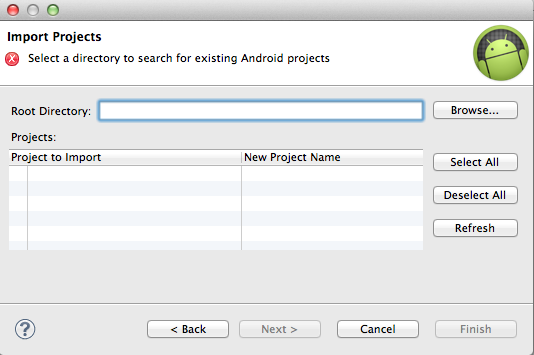
-- Once the myfirstapp is selected click finish. The project should be imported and ready to run.
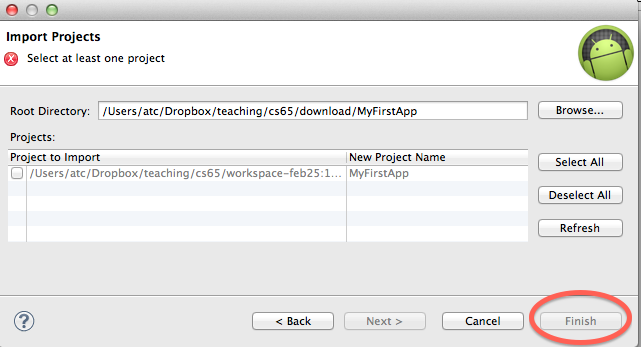
If for some reason there are errors try a clean. This is always a good thing to do if there are spurious errors in a project you know is clean.
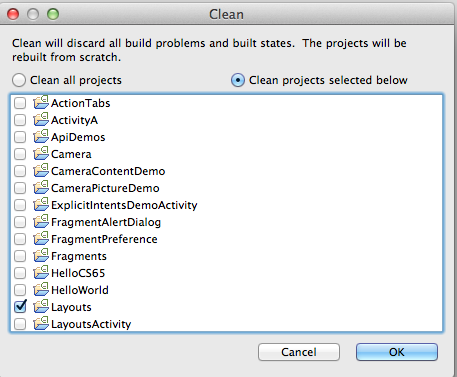
Hope that helped.
This application moves things forward. First it includes two activities. The main activity starts the second activity using an intent. When the user inputs a message on the UI of the first activity and clicks send the message is bundled up in an intent and the display activity started -- which displays the message on its own UI. Take a look at the screen dumps below: the first one is the UI rendered by the MainActivity UI, next the user enters a message and clicks the Send button -- and wham -- the DisplayMessageActivity is started to display the message in a larger -- sort of uncool -- font. There is a lot more to this simple program. Note, the menus for each UI is different. You can navigate back using the Up button instead of the back button from the DisplayMessageActivity UI. More on this later.
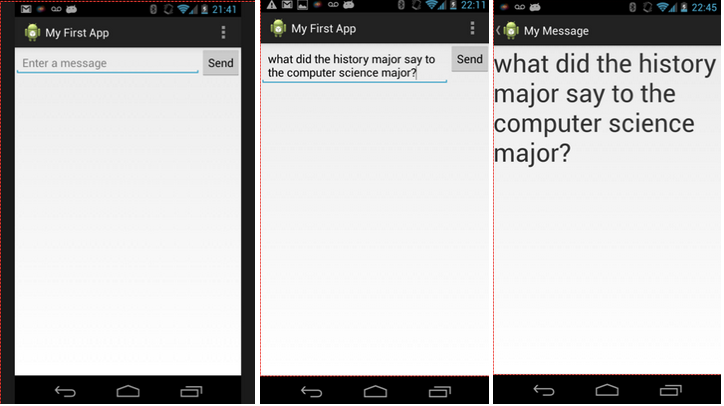
This program -- myFirstApp -- is taken from the Android developers with minor modifications.
Open the src folder and look at the MainActivity.java code.
<?xml version="1.0" encoding="utf-8"?>
<LinearLayout xmlns:android="http://schemas.android.com/apk/res/android"
xmlns:tools="http://schemas.android.com/tools"
android:layout_width="match_parent"
android:layout_height="match_parent"
android:orientation="horizontal" >
</LinearLayout> <EditText android:id="@+id/edit_message"
android:layout_width="wrap_content"
android:layout_height="wrap_content"
android:hint="@string/edit_message" />By default, your Android project includes a string resource file at res/values/strings.xml. Add a new string named "edit_message" and set the value to "Enter a message." (You can delete the "hello_world" string.)
While you’re in this file, also add a "Send" string for the button you’ll soon add, called "button_send".
<?xml version="1.0" encoding="utf-8"?>
<resources>
<string name="app_name">My First App</string>
<string name="edit_message">Enter a message</string>
<string name="button_send">Send</string>
<string name="menu_settings">Settings</string>
<string name="title_activity_main">MainActivity</string>
</resources><Button
android:layout_width="wrap_content"
android:layout_height="wrap_content"
android:text="@string/button_send" /> <EditText
android:layout_weight="1"
android:layout_width="0dp"
... />Open the activity_main.xml file from the res/layout/ directory.
<?xml version="1.0" encoding="utf-8"?>
<LinearLayout xmlns:android="http://schemas.android.com/apk/res/android"
xmlns:tools="http://schemas.android.com/tools"
android:layout_width="match_parent"
android:layout_height="match_parent"
android:orientation="horizontal">
<EditText android:id="@+id/edit_message"
android:layout_weight="1"
android:layout_width="0dp"
android:layout_height="wrap_content"
android:hint="@string/edit_message" />
<Button
android:layout_width="wrap_content"
android:layout_height="wrap_content"
android:text="@string/button_send" />
</LinearLayout> <Button
android:layout_width="wrap_content"
android:layout_height="wrap_content"
android:text="@string/button_send"
android:onClick="sendMessage" />There are a number of useful short cuts.
In Eclipse, press Ctrl + Shift + O to import missing classes (Cmd + Shift + O on Mac).
In Eclipse, press Ctrl + Shift + F to correctly format your code once you have entered it (Cmd + Shift + F on Mac).
In Eclipse, press Ctrl + Shift + C to correctly format your code once you have entered it (Cmd + Shift + C on Mac). You can also enter plain text comments, highlight your code and the type Cmd + Shift + C to comment it.
In Eclipse, present project => clean to clean the project. Many times there are complication or project changes that cause problems. Cleaning the project before running it clears these problems.
Many times you will run into Android programming or Eclipse environment problems. There is a really nice set of tips for solving a common set of problems.
Open the MainActivity class (located in the project's src/ directory) and add the corresponding method:
package edu.dartmouth.cs.myfirstapp;
import android.app.Activity;
import android.content.Intent;
import android.os.Bundle;
import android.view.Menu;
import android.view.View;
import android.widget.EditText;
public class MainActivity extends Activity {
public final static String EXTRA_MESSAGE = "com.example.myfirstapp.MESSAGE";
@Override
protected void onCreate(Bundle savedInstanceState) {
super.onCreate(savedInstanceState);
setContentView(R.layout.activity_main);
}
@Override
public boolean onCreateOptionsMenu(Menu menu) {
// Inflate the menu; this adds items to the action bar if it is present.
getMenuInflater().inflate(R.menu.activity_main, menu);
return true;
}
/** Called when the user clicks the Send button */
public void sendMessage(View view) {
// Do something in response to button
Intent intent = new Intent(this, DisplayMessageActivity.class);
EditText editText = (EditText) findViewById(R.id.edit_message);
String message = editText.getText().toString();
intent.putExtra(EXTRA_MESSAGE, message);
}
}The EXTRA_MESSAGE, message represents a value/key pair passed in the intent. You need to define the key in the MainActivity
**TIP Recall from above: press Ctrl + Shift + O to import missing classes (Cmd + Shift + O on Mac).
To start an activity, call startActivity() and pass it your Intent. The system receives this call and starts an instance of the Activity specified by the Intent.
With this new code, the complete sendMessage() method that's invoked by the Send button now looks like this:
.....
// Send the input string to the DisplayMessageActivity using an intent
Intent intent = new Intent(this, DisplayMessageActivity.class);
EditText editText = (EditText) findViewById(R.id.edit_message);
String message = editText.getText().toString();
intent.putExtra(EXTRA_MESSAGE, message);
startActivity(intent);
}
...Now you need to create the DisplayMessageActivity class in order for this to work.
To create a new activity using Eclipse:
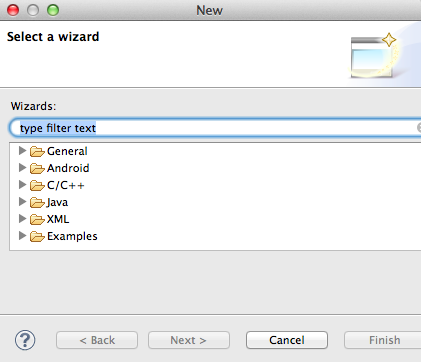
n the window that appears, open the Android folder and select Android Activity. Click Next.
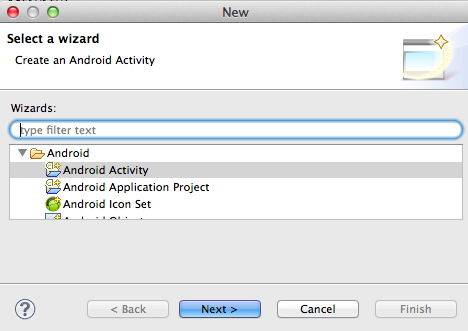
Select BlankActivity and click Next.

Fill in the activity details:

Finally click Finish.
If you're using a different IDE or the command line tools, create a new file named DisplayMessageActivity.java in the project's src/ directory, next to the original MainActivity.java file.
The DisplayMessageActivity class should now look like this:
package edu.dartmouth.cs.myfirstapp;
import android.os.Bundle;
import android.app.Activity;
import android.view.Menu;
import android.view.MenuItem;
import android.support.v4.app.NavUtils;
public class DisplayMessageActivity extends Activity {
@Override
protected void onCreate(Bundle savedInstanceState) {
super.onCreate(savedInstanceState);
setContentView(R.layout.activity_display_message);
// Show the Up button in the action bar.
getActionBar().setDisplayHomeAsUpEnabled(true);
}
@Override
public boolean onCreateOptionsMenu(Menu menu) {
// Inflate the menu; this adds items to the action bar if it is present.
getMenuInflater().inflate(R.menu.activity_display_message, menu);
return true;
}
@Override
public boolean onOptionsItemSelected(MenuItem item) {
switch (item.getItemId()) {
case android.R.id.home:
// This ID represents the Home or Up button. In the case of this
// activity, the Up button is shown. Use NavUtils to allow users
// to navigate up one level in the application structure. For
// more details, see the Navigation pattern on Android Design:
//
// http://developer.android.com/design/patterns/navigation.html#up-vs-back
//
NavUtils.navigateUpFromSameTask(this);
return true;
}
return super.onOptionsItemSelected(item);
}
}When you create an activity it provides a number of default methods which we will not use in this project. Remove:
The DisplayMessageActivity class should now look like this:
package edu.dartmouth.cs.myfirstapp;
import android.os.Bundle;
import android.app.Activity;
import android.view.Menu;
import android.view.MenuItem;
import android.support.v4.app.NavUtils;
public class DisplayMessageActivity extends Activity {
@Override
protected void onCreate(Bundle savedInstanceState) {
super.onCreate(savedInstanceState);
setContentView(R.layout.activity_display_message);
// Show the Up button in the action bar.
getActionBar().setDisplayHomeAsUpEnabled(true);
}
@Override
public boolean onOptionsItemSelected(MenuItem item) {
switch (item.getItemId()) {
case android.R.id.home:
// This ID represents the Home or Up button. In the case of this
// activity, the Up button is shown. Use NavUtils to allow users
// to navigate up one level in the application structure. For
// more details, see the Navigation pattern on Android Design:
//
// http://developer.android.com/design/patterns/navigation.html#up-vs-back
//
NavUtils.navigateUpFromSameTask(this);
return true;
}
return super.onOptionsItemSelected(item);
}
}If you get an error with getActionBar().setDisplayHomeAsUpEnabled(true) make sure that the minium API to 11 in the manifest as shown below. Because the ActionBar APIs are available only on HONEYCOMB (API level 11) and higher, you must add a condition around the getActionBar() method to check the current platform version
<manifest xmlns:android="http://schemas.android.com/apk/res/android"
package="edu.dartmouth.cs.myfirstapp"
android:versionCode="1"
android:versionName="1.0" >
<uses-sdk
android:minSdkVersion="11"
android:targetSdkVersion="17" />
.....By setting the minimum API to 11 the error is cleared.
Take a look at the XML for the new activity .DisplayMessageActivity in the manifest. The code is self explanatory.
<application ... >
...
<activity
android:name="edu.dartmouth.cs.myfirstapp.DisplayMessageActivity"
android:label="@string/title_activity_display_message"
android:parentActivityName="edu.dartmouth.cs.myfirstapp.MainActivity" >
<meta-data
android:name="android.support.PARENT_ACTIVITY"
android:value="edu.dartmouth.cs.myfirstapp.MainActivity" />
</activity>
</application>You can run the app now, but not much happens. Clicking the Send button starts the second activity but it uses a default "Hello world" layout provided by the template. You'll soon update the activity to instead display a custom text view.
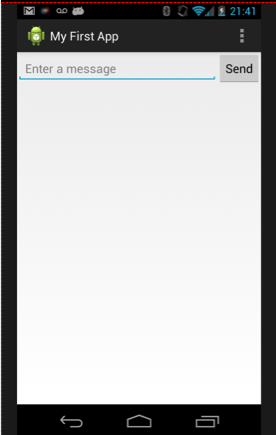
In the DisplayMessageActivity class’s onCreate() method, get the intent and extract the message delivered by MainActivity:
import android.app.Activity;
import android.content.Intent;
import android.os.Bundle;
import android.support.v4.app.NavUtils;
import android.view.MenuItem;
public class DisplayMessageActivity extends Activity {
@Override
protected void onCreate(Bundle savedInstanceState) {
super.onCreate(savedInstanceState);
setContentView(R.layout.activity_display_message);
// Show the Up button in the action bar.
getActionBar().setDisplayHomeAsUpEnabled(true);
// Get the message from the intent
Intent intent = getIntent();
String message = intent.getStringExtra(MainActivity.EXTRA_MESSAGE);
}
......To show the message on the screen, create a TextView widget and set the text using setText(). Then add the TextView as the root view of the activity’s layout by passing it to setContentView().
The complete onCreate() method for DisplayMessageActivity now looks like this:
import android.app.Activity;
import android.content.Intent;
import android.os.Bundle;
import android.support.v4.app.NavUtils;
import android.view.MenuItem;
import android.widget.TextView;
public class DisplayMessageActivity extends Activity {
@Override
public void onCreate(Bundle savedInstanceState) {
super.onCreate(savedInstanceState);
// Get the message from the intent
Intent intent = getIntent();
String message = intent.getStringExtra(MainActivity.EXTRA_MESSAGE);
// Create the text view
TextView textView = new TextView(this);
textView.setTextSize(40);
textView.setText(message);
// Set the text view as the activity layout
setContentView(textview);
}
......You should see the following screens on your phone or emulator

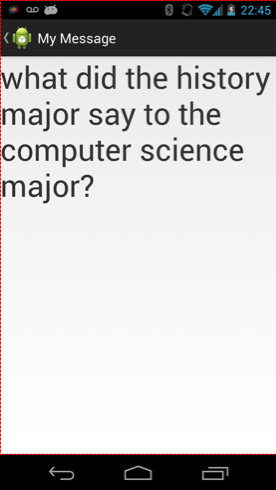
You can put print or log statements your code. You might want to confirm for example that an intent fired by one activity is received by another. You can use Log.d() to do this. You have to first create a TAG in your code and then call Log.d() with the tag.
In the code snippet below that you need to import android.util.Log, set up the TAG, and then call Log.d()
package edu.dartmouth.cs.myfirstapp;
import android.app.Activity;
import android.content.Intent;
import android.os.Bundle;
import android.support.v4.app.NavUtils;
import android.util.Log;
import android.view.MenuItem;
import android.widget.TextView;
public class DisplayMessageActivity extends Activity {
private static final String TAG = "MyFirstApp";
@Override
public void onCreate(Bundle savedInstanceState) {
super.onCreate(savedInstanceState);
// Get the message from the intent
Intent intent = getIntent();
String message = intent.getStringExtra(MainActivity.EXTRA_MESSAGE);
Log.d(TAG, "Got Intent");
// Create the text view
TextView textView = new TextView(this);
textView.setTextSize(40);
textView.setText(message);
// Set the text view as the activity layout
setContentView(textView);
}
......An easy way to monitor the output from log.d is to use the LogCat utility. LogCat is integrated into ADT/Eclipse. You’ll find the LogCat panel integrated into the DDMS and Debug perspectives of Eclipse.
You first need to set up a filter in LogCat and then run the program and then filter on the TAG name (which in our example is MyFirstApp.
To set up a filter click on the green cross; then set up the filter as shown. Examples of the code for setting up the TAG and calling Log.() are also highlighted on the figure below.
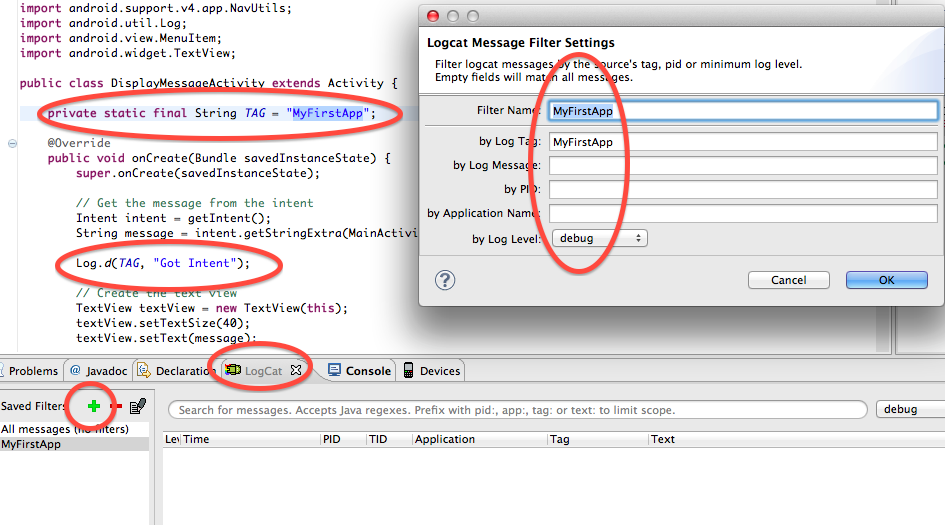
Once you click on run and enter input you will see to logs printed out from the application: one when the user clicks send at the UI; and one when DisplayMessageActivity receives the Intent and prints the message, as show below.

This is a simple example of logging applications. Much more sophisticated logging can be done. More later on this.
Using can use toast which is displayed to the screen for a period of time. This allows you to quickly check simple control flow.
public class DisplayMessageActivity extends Activity {
@Override
protected void onCreate(Bundle savedInstanceState) {
super.onCreate(savedInstanceState);
setContentView(R.layout.activity_display_message);
// Show the Up button in the action bar.
getActionBar().setDisplayHomeAsUpEnabled(true);
Toast.makeText(getApplicationContext(), "DisplayMessageActivity", Toast.LENGTH_LONG).show();
// Get the message from the intent
Intent intent = getIntent();
String message = intent.getStringExtra(MainActivity.EXTRA_MESSAGE);
.....